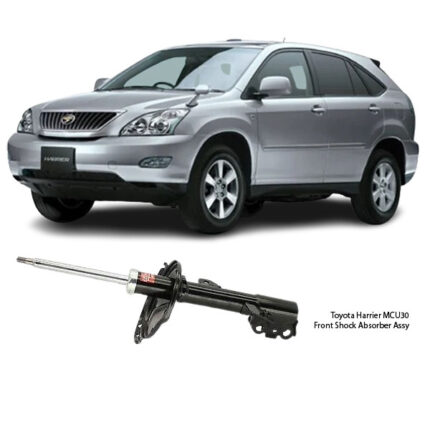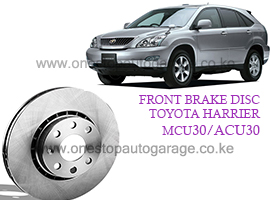-9%
Get Toyota Harrier 240 Front Brake Pad Kit 04465-48100 in Kenya
The front brake pad kit is one of the most critical components of your vehicle’s braking system. Whether you drive a Toyota Prado 120/150, Nissan Note, Wingroad, Tiida, or any other vehicle, having a high-quality front brake pad kit ensures shorter stopping distances, smoother braking, and increased safety.
Since the front brakes handle 60-70% of braking force, using reliable and durable brake pads is essential for both performance and safety. In this guide, we’ll discuss how front brake pads work, the different types available, signs of wear, installation steps, and maintenance tips.
What Are Front Brake Pads? 🛑
Brake pads are the components that press against the brake rotors (discs) to create the friction needed to slow down or stop a vehicle. The front brake pad kit typically includes:
🔹 Brake Pads (Left & Right) – The friction material that makes contact with the rotor.
🔹 Shims – Help reduce noise and vibrations.
🔹 Clips & Springs – Ensure proper alignment and movement.
Unlike rear brake pads, the front brake pads experience higher stress and wear out faster due to the weight transfer when braking.
Types of Front Brake Pads 🔧
Not all brake pads are the same! The type of material used affects performance, durability, and braking efficiency.
1️⃣ Semi-Metallic Brake Pads
✔️ Made from metal fibers mixed with resin
✔️ Excellent stopping power
✔️ Perform well in high temperatures
✔️ Can be noisier and cause rotor wear
2️⃣ Ceramic Brake Pads
✔️ Made from ceramic fibers with copper or other additives
✔️ Offer quiet, smooth braking
✔️ Last longer and produce less brake dust
✔️ More expensive than semi-metallic pads
3️⃣ Organic (NAO) Brake Pads
✔️ Made from rubber, carbon, and other organic materials
✔️ Softer and quieter but wear out faster
✔️ Suitable for light vehicles and city driving
For SUVs and trucks like the Toyota Prado 120/150, semi-metallic or ceramic brake pads are recommended due to their durability and braking efficiency.
Why Are High-Quality Front Brake Pads Important? 🚘
Front brake pads play a critical role in stopping power and overall vehicle safety. Using high-quality brake pads ensures:
🔹 Shorter Stopping Distance – Essential in emergency braking situations.
🔹 Less Brake Fade – Prevents loss of braking power due to overheating.
🔹 Improved Stability – Helps maintain control during hard braking.
🔹 Even Brake Wear – Reduces stress on other braking components.
🔹 Longer Rotor Life – Prevents excessive wear on the brake discs.
Worn-out or low-quality brake pads can cause dangerous braking issues such as longer stopping distances, increased wear on the rotors, and potential brake failure.
Signs That Your Front Brake Pads Need Replacement 🚨
Over time, brake pads wear down due to friction and heat. Here are some signs that indicate it’s time for replacement:
🔧 Squeaking or Squealing Noises – Caused by wear indicators or lack of lubrication.
🚗 Grinding Noise – Indicates that the brake pads are completely worn out, leading to metal-on-metal contact.
🛞 Longer Braking Distance – Reduced stopping power can be dangerous.
⚠️ Brake Warning Light – Some vehicles have a sensor that alerts you when pads are low.
💨 Excessive Brake Dust – More dust buildup on wheels may indicate pad wear.
🏎️ Vibrations or Pulsation When Braking – Could be due to warped rotors or uneven brake pad wear.
If you experience any of these warning signs, inspect your brake pads and replace them as needed.
How to Replace Front Brake Pads – Step-by-Step Guide 🛠️
Replacing front brake pads is a straightforward task that can be done at home with basic tools.
Tools Needed 🧰
✔️ Jack & jack stands
✔️ Lug wrench
✔️ Socket wrench
✔️ C-clamp or brake caliper tool
✔️ Brake cleaner
✔️ New front brake pad kit
Installation Steps 🔩
1️⃣ Park on a Level Surface – Engage the parking brake and use wheel chocks.
2️⃣ Loosen the Lug Nuts – Before jacking up the car.
3️⃣ Jack Up the Vehicle – Secure it with jack stands.
4️⃣ Remove the Front Wheels – To access the brake caliper.
5️⃣ Unbolt the Brake Caliper – Use a socket wrench to remove the bolts.
6️⃣ Remove the Old Brake Pads – Slide them out carefully.
7️⃣ Clean the Brake Components – Use brake cleaner to remove dust and debris.
8️⃣ Install the New Brake Pads – Insert them into the caliper bracket.
9️⃣ Compress the Brake Caliper Piston – Use a C-clamp to push the piston back.
🔟 Reassemble Everything – Bolt the caliper back and reinstall the wheel.
1️⃣1️⃣ Pump the Brake Pedal – Ensures proper brake engagement before driving.
💡 Tip: Always check the brake fluid level after changing brake pads.
OEM vs Aftermarket Front Brake Pads 🏁
When replacing front brake pads, you can choose between:
🔹 OEM (Original Equipment Manufacturer):
✔️ Specifically designed for your vehicle
✔️ Perfect fit and reliability
✔️ Higher cost but better long-term performance
🔹 Aftermarket Brake Pads:
✔️ Wide variety of brands and materials
✔️ Some offer higher performance (ceramic or semi-metallic)
✔️ Quality varies – choose reputable brands
For Toyota Prado 120/150, Nissan Note, Wingroad, and Tiida, OEM brake pads are best for daily driving, while ceramic or semi-metallic aftermarket options work well for heavy-duty or high-performance needs.
Maintenance & Longevity Tips 🏎️
To extend the lifespan of your front brake pads, follow these maintenance tips:
✅ Inspect Brake Pads Every 20,000 km – Look for wear and thickness.
✅ Check Brake Fluid Levels – Low fluid can indicate brake system issues.
✅ Avoid Sudden Braking – Reduces pad wear and heat buildup.
✅ Clean the Brake System – Prevents dust and debris buildup.
✅ Replace Both Sides at the Same Time – Ensures even braking performance.
Proper maintenance prevents premature wear and costly repairs.
Common Questions About Front Brake Pads 🤔
1️⃣ How long do front brake pads last?
On average, front brake pads last 40,000 – 70,000 km, depending on driving conditions.
2️⃣ Can I drive with worn-out front brake pads?
No. Worn-out brake pads increase stopping distance and risk brake failure, making driving dangerous.
3️⃣ How much does it cost to replace front brake pads?
Expect $50 – $200 for a front brake pad kit, plus labor costs if done at a shop.
4️⃣ Do I need to replace rotors when changing brake pads?
Not always, but if rotors are worn or warped, they should be resurfaced or replaced.
5️⃣ How do I check front brake pad wear?
Visually inspect the pad thickness (should be at least 3-4mm thick) or listen for squealing noises.
Final Thoughts 💭
The front brake pad kit is crucial for safe and effective braking. Whether you drive a Toyota Prado 120/150, Nissan Note, Wingroad, or Tiida, using high-quality brake pads improves performance, safety, and durability.
Follow us on Facebook for more parts.




